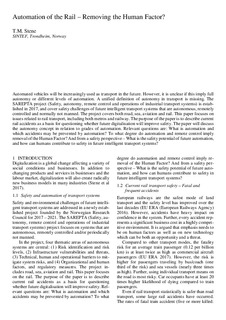| dc.description.abstract | Digitalization is a global change affecting a variety of social conditions and businesses. In addition to changing products and services in businesses and the labour market, digitalization will also create radically new business models in many industries (Stene et al 2017). Automated vehicles will be increasingly used as transport in the future. However, it is unclear if this imply full autonomy or different levels of automa-tion. A unified definition of autonomy in transport is missing. 1.1 Safety and automation of transport systems Safety and environmental challenges of future intel-ligent transport systems are addressed in a newly es-tablished project founded by the Norwegian Re-search Council for 2017 – 2021. The SAREPTA pro-ject (Safety, autonomy, remote control and opera-tions of industrial transport systems) is established in 2017, and cover safety challenges of future intelli-gent transport systems that are autonomous, remote-ly controlled and normally not manned. The project covers both road, sea, aviation and rail. This paper focuses on issues related to rail transport, including both metros and railway. The purpose of the paper is to describe current rail acci-dents as a basis for questioning whether future digi-talisation will improve safety. The paper discusses the autonomy concept in relation to grades of auto-mation. Relevant questions are: What is automation and which accidents may be prevented by automa-tion? To what degree do automation and remote control imply removal of the Human Factor? And from a safety perspective – What is the safety poten-tial of future automation, and how can humans con-tribute to safety in future intelligent transport sys-tems? 1.2 Future automated trains and metros With more people living in urban areas than ever be-fore, metro systems around the world will need to adapt (Lufkin 2015). The next generation of sub-ways will develop from cities that are already at the cutting-edge. Self-driving trains are already being used in some countries, with varying degrees of autonomy. Sever-al pilots are currently running including technologies to detect obstacles, self-driving trains on main lines 1.3 The Human Factor in future rail systems Technology can improve safety, but there may be examples where human interaction is necessary. The development relies too heavily on old inertia, mean-ing too much emphasize on technology. More atten-tion should be paid to the organization, passengers, the infrastructure and passenger evacuation proce-dures. Based on experiences from operating both auto-mated and conventional metro lines, one conclusion is that the human factor is that key for the success of an automated line. (UITP 2016). The rail is far from being autonomous, in the sense of being independent of a human operator. Humans will still be a necessary resource to manage transport and cope with unex-pected incidents. | nb_NO |
